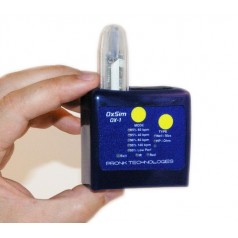Pronk Technologies PREOWNED OX-1 OxSim Optical Spo2 Simulator
THIS ITEM IS BIOMEDEQUIP'S #1 MOST POPULAR SELLING ITEM! THIS UNIT IS A PREOWNED UNIT THAT HAS BEEN REFURBISHED BY THE MANUFACTURER.
WARRANTY: One Year Warranty
SALES LEAD TIME: 14 Business Days as we have to send out for a fresh calibration.
ACCESSORIES: Soft Carrying Case, Battery Eliminator, Operator Manual, Fresh Calibration Certificate
FEATURES:
4 Saturation Rates
3 Pulse Rates
Low Perfusion Mode
Fits in your SimCube Case
Runs on one AA Battery.
Has a sleep mode.
Accurate Readings
COMPATIBLE SENSOR TESTING
Nell/Mas Setting:
All Nellcor
Masimo
Datascope
Protocol
Spacelabs
HP/Philips (blue extension cable)
HP/Philips (tan soft sensor)
Nihon Kohden
Colin
GE/Marquette
Welch Allyn
HP/Ohm Setting:
HP/Philips (cocoa brown soft sensor)
Ohmeda
Novametrix
MODES:
85%: Simulates a patient with saturation of 85%, heart rate of 80bpm, and perfusion index of approximately 2.0
95%: Simulates a patient with saturation of 95%, heart rate of 40bpm, and perfusion index of approximately 2.0 NOTE: This heart rate is right at the limit of the performance specification for many oximeters and some may have trouble with it.
98%: Simulates a patient with saturation of 98%, heart rate of 80bpm, and perfusion index of approximately 2.0
140BPM: Simulates a patient with a saturation of 98%, heart rate of 140bpm, and a perfusion index of approximately 2.0
Low Perfusion: Simulates a patient with a saturation of 99%, heart rate of 80bpm, and a perfusion index of approximately 0.2. Note that this mode simulates a challengingly low perfusion level and will not work with all monitors or sensors.
A NOTE ON SPO2 SENSORS:
Durable Spo2 sensors have a tolerance spec of +/-2%, disposable Spo2 sensors have a tolerance spec of +/-2% or +/-3%, and most oximeters have an additional tolerance spec of +/-1%. This points towards a theoretical error total of up to 4%, but in most cases it should be possible to achieve oximeter readings within 2% of the values labeled on the OxSim.
OPERATION NOTES:
Sensor-LED Indicators: The OxSim has two LEDs near the bottom of its display labeled "IR" and "RED". The LED labeled "IR" illuminates when a significant amount of IR light is detected on the input side of the finger and the LED labeled "RED" illuminates when a significant amount of Red light is detected on the input side of the finger. When a properly working oximeter and sensor are connected to the OxSim, both LEDs should be solidly illuminated (not flashing). Sensor failures can often be detected by just checking these LEDs.
Power Save Mode: When no sensor is connected to the OxSim for 10 minutes, it shuts itself off to save power. To turn it back on you can either power cycle it, or press either of the Mode or Type buttons. The OxSim will not remember your prior Mode or Type settings, so when you turn it back on be sure to reconfigure them.
Battery Level Indicator: The OxSim will perform active Spo2 simulation for approximately 8 to 12 hours on a single AA battery, depending primarily on the brightness of the light emitted by the oximeter it is testing. When the battery condition is good (loaded battery voltage in the range of 1.6v to about 1.1v...about 80% of the total run time) the battery indicator will be green. When the battery condition is marginal (loaded battery voltate in the range of 1.1V to 1V...about 15% of the total run time) the battery indicator will be orange. When the battery is depleted the battery indicator will be red. When the battery indicator is red, the OxSim may boot and appear to operate correctly, but may reset when a Spo2 sensor is installed







